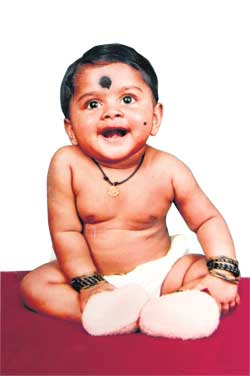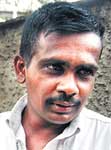
|
‘Our little baby has only one hand now’ Was it a case of inadequate facilities in the state health sector that led to the amputation of baby Sewmini’s hand, is the broader question that needs to be probed says Kumudini Hettiarachchi The parents of baby Sewmini, just one year and two months, never in their worst imaginings thought that a visit to a hospital would tragically change their lives and that of their one and only little girl forever. The events that would have a drastic impact on the trio began on September 30. “She had high fever, a bad cough and hathiya,” says her mother Ashoka Dayananda who has been by Sewmini since the ordeal began. They had taken medication from a private doctor in Galagedera, where their home is. But the medicine didn’t seem to work, so they admitted her to the Galagedera Hospital on September 30, where she was treated with medication injected through a canula.
“Although the fever subsided, the cough didn’t, and the staff at Galagedera told us to get an X-ray done at the Kandy Hospital,” says Ashoka, whose husband earns a living as a mason. The family did as they were told and on October 6, dutifully sought treatment at Kandy, where they were told that the X-ray indicated their little one was coming in for pneumonia. “It was poya,” recalls the mother sadly. Treatment began at Kandy too, with the canula being changed every two days. However, on October 12, the mother realized that something was wrong, because Sewmini was crying and the tip of the little finger of her left hand was slightly bluish. “Earlier when we told the nurses that the child was restless, the nurses said that it was not possible to keep changing the canula so many times,” says Ashoka, close to tears. When the fingers began turning blue, the staff got activated and ultimately transferred Sewmini to the Lady Ridgeway Children’s Hospital in Colombo in the early hours of October 13. “Taken to the National Hospital (NHSL) on the 14th, she was brought back to LRH for the first operation which was to open up the arm,” says Ashoka explaining that still the hand shrivelled up, while husband U.G. Dayananda adds that even after the operation the hand looked like a crow’s claw, all black and disfigured. The same night (October 14) she was transferred to NHSL. Subsequently, on October 19, the National Hospital requested Ashoka to sign the forms giving her consent to amputate the baby’s hand. “My husband didn’t want it done, but they told me that if the hand was not amputated other parts of her body would get affected and her life would be in danger,” she says attempting with difficulty to come to terms with this tragic turn of events. Sewmini was finally brought back to LRH on October 21. My little one thinks the hand is still there and attempts to wave it around and pull off the bandages, Ashoka adds as tears fill her eyes. When contacted, NHSL’s Acting Director Dr. Rani Fernando said the child was transferred to the National Hospital from the Kandy General Hospital. The medication which should have gone into the vein had gone into the artery and the artery had thrombosed. The doctors attempted to increase the blood flow to the hand but failed and to save the child’s life the hand had to be amputated. “The amputation was a life-saving measure,” she said adding that the operation was performed by Prof. Mandika Wijeratne.
The Sunday Times understands that when the Kandy General Hospital staff realized the problem, they immediately contacted the Peradeniya Hospital, as Kandy does not have a vascular surgeon who is required to deal with such an emergency. Unfortunately, the Peradeniya vascular surgeon had been on leave. After contacting the National Hospital which has two vascular surgeons, the child had been transferred to the LRH, with the NHSL vascular surgeons attending to her. While an inquiry is essential to check out what went wrong in Sewmini’s case, there is also an urgent need to look at the state health sector more carefully. Is this a straightforward black and white issue or are there grey areas the Health Ministry needs to probe. Do hospitals which deal with life and death matters, have all the facilities required to perform their work? What of the staff? There is no doubt that the state health sector has a very well- trained workforce, but are there adequate numbers to handle the thousands of needy men, women and children who throng the state hospitals? A closer and inward look not only with the motive of pointing fingers but also in an attempt to verify the truth may reveal some major shortcomings for which everyone, from the topmost post in the Health Ministry may have to say mea culpa, mea culpa, mea culpa.
|
| || Front
Page | News
| Editorial
| Columns
| Sports
| Plus
| Financial
Times | International
| Mirror
| TV
Times | Funday
Times || |
| |
Copyright
2006 Wijeya
Newspapers Ltd.Colombo. Sri Lanka. |

